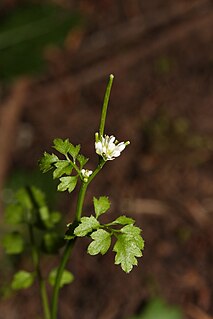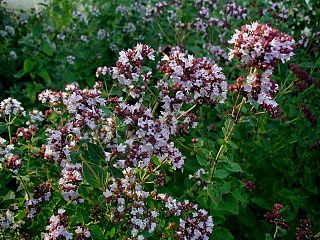
Arabidopsis (rockcress) is a genus in the family Brassicaceae. They are small flowering plants related to cabbage and mustard. This genus is of great interest since it contains thale cress, one of the model organisms used for studying plant biology and the first plant to have its entire genome sequenced. Changes in thale cress are easily observed, making it a very useful model.

The docks and sorrels, genus Rumex L., are a genus of about 200 species of annual, biennial, and perennial herbs in the buckwheat family Polygonaceae.

Cardamine is a large genus of flowering plants in the mustard family, Brassicaceae, known as bittercresses and toothworts. It contains more than 200 species of annuals and perennials. Species in this genus can be found worldwide, except the Antarctic, in diverse habitats. The name Cardamine is derived from the Greek kardamon, cardamom, an unrelated plant in the ginger family, used as a pungent spice in cooking.

Origanum is a genus of herbaceous perennials and subshrubs in the family Lamiaceae, native to Europe, North Africa, and much of temperate Asia, where they are found in open or mountainous habitats. A few species also naturalized in scattered locations in North America and other regions.

Draba is a large genus of flowering plants in the cabbage family Brassicaceae (Cruciferae), commonly known as whitlow-grasses.

Teucrium chamaedrys, the wall germander, is a species of ornamental plant native to Mediterranean region of Europe and North Africa, and to the Middle East as far east as Iran. It was historically used as a medicinal herb for the treatment of gout and sometimes as a component of Venice treacle.

Biscutella is a genus of about 46 species of flowering plants of Brassicaceae or Cruciferae family, according to Appel, O. & Al-Shehbaz, I. 2003.
Eudema is a genus of flowering plant in the family Brassicaceae from South America. It contains six species, including Eudema nubigena.
Lachnocapsa spathulata is a species of flowering plant in the Brassicaceae family, and the only species in the genus Lachnocaspa. It is found only on Socotra, Yemen. Its natural habitats are subtropical or tropical dry shrubland and rocky areas.

Peltaria is a genus of flowering plants, within the family Brassicaceae. Their distribution ranges from Southeast Europe, Near East to Central Asia. They prefer rocky slopes.

Hornungia is a small genus of plants in the mustard family. It currently contains three species that have previously been classified as members of other genera, including Hutchinsia and Pritzelago. The genera, and sometimes several others, are usually treated as synonyms.
Ihsan Ali Al-Shehbaz, Ph.D. is an Iraqi American botanist who works as Adjunct Professor at University of Missouri-St. Louis and Senior Curator at Missouri Botanical Garden. Al-Shehbaz's primary area of interest is Brassicaceae and The Durango Herald called him "a world expert on taxonomy of the family". A 2008 publication of the United States Fish and Wildlife Service called him "the world's authority on species in the genus Lesquerella". The author abbreviation "Al-Shehbaz" is attached to the numerous botanical taxa he has identified.

Halothamnus is a genus of the subfamily Salsoloideae in the family Amaranthaceae. The scientific name means saltbush, from the Greek ἅλς (hals) "salt" and θαμνος (thamnos) "bush". This refers either to salty habitats or to the accumulation of salt in the plants. The genus is distributed from Southwest and Central Asia to the Arabian peninsula and East Africa.

Galitzkya is a genus of 3 species of flowering plants of Brassicaceae or Cruciferae family, according to Appel, O. & Al-Shehbaz, I. 2003.
Graellsia is a genus of small perennial sub-caespitose herbs in the family Brassicaceae / Cruciferae. Most of the species are found in Iran and Afghanistan, with one occurring in Turkey, and one in the High Atlas of Morocco. They are typically found in shady crevices of calcareous rocks at altitudes of 1,000–3,600 metres (3,300–11,800 ft).

Anabasis is a genus of the subfamily Salsoloideae in the family Amaranthaceae. It is distributed in southern Europe, North Africa, and Asia.
Petroravenia is a genus of plants in the Brassicaceae, first described in 1994. There are to date only two species proposed as members of the genus:
Solms-laubachia is a high-altitude genus of perennial herbs in the family Brassicaceae. It is named for the German botanist Hermann zu Solms-Laubach.













